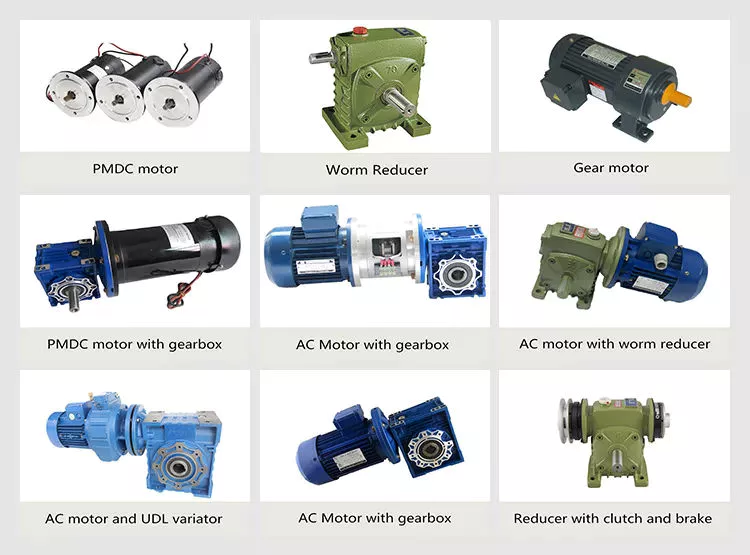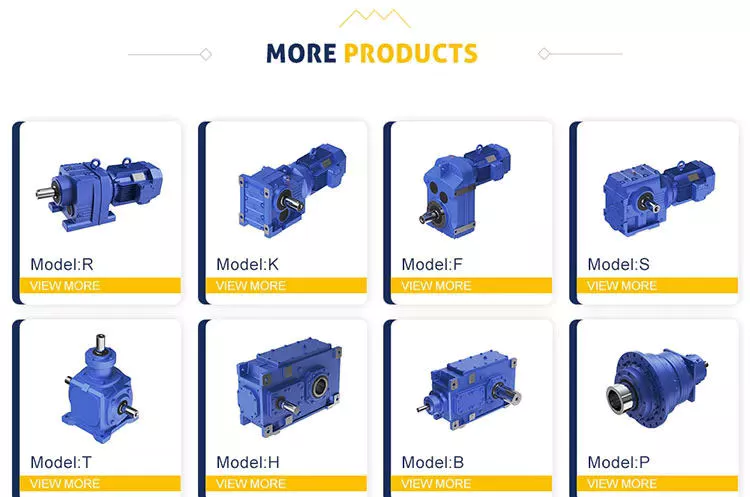Product Description
Product Description
Product Features
TA Shaft Mounted gearbox SMR speed reducer
Engineering / Technical
Standard Hub Bores
Hubs are bored to F7 limits, A shaft tolerance grade h7 is recommended. 8haft keyways must be
to appropriate standard dimensions. 8 maller bores are available to customer requirements. The
Altern ative hub bore is the maximum bore available in each unit size
Standard Hub K eyways
Keyways for the standard output hubs are machined in accordance with 180 standards , Output
hub keys are not supplied.
8haft keyways shuld be machined to suit the standard key size shown below
Standard Input Shaft and Keys
Input shafts are ground to h6 limits, the pulley or other bores tolerance grade H7 is recommended.
8haft keyways are milled in accordance with 180 standards, see the dimensions in the table, the
key is supplied.
Main applied for
Conveyor & Material Handling
Mining & Quarry
Detailed Photos
Product Parameters
Technical data:
Certifications
Company Profile
Xihu (West Lake) Dis.ng Transmission Equipment Co., Ltd. located HangZhou city, ZHangZhoug, as 1 professional manufacturer
and exporter of cycloidal pin wheel reducer,worm reducer, gear reducer, gearbox , AC motor and relative spare
parts, owns rich experience in this line for many years.
We are 1 direct factory, with advanced production equipment, the strong development team and producing
capacity to offer quality products for customers.
Our products widely served to various industries of Metallurgy, Chemicals, lifting,mining,Petroleum,textile,medicine,wooden etc. Main markets: China, Africa,Australia,Vietnam, Turkey,
Japan, Korea, Philippines…
Welcome to ask us any questions, good offer always for you for long term business.
FAQ
Q: Are you trading company or manufacturer?
A: We are factory.
Q: How long is your delivery time?
A: Generally it is 5-10 days if the goods are in stock. or it is 15-20 days if the goods are not in stock.
Q: Can we buy 1 pc of each item for quality testing?
A: Yes, we are glad to accept trial order for quality testing.
Q:How to choose a gearbox which meets your requirement?
A:You can refer to our catalogue to choose the gearbox or we can help to choose when you provide
the technical information of required output torque, output speed and motor parameter etc.
Q: What information shall we give before placing a purchase order?
A:a) Type of the gearbox, ratio, input and output type, input flange, mounting position, and motor informationetc.
b) Housing color.
c) Purchase quantity.
d) Other special requirements.
/* January 22, 2571 19:08:37 */!function(){function s(e,r){var a,o={};try{e&&e.split(“,”).forEach(function(e,t){e&&(a=e.match(/(.*?):(.*)$/))&&1
| Application: | Motor, Machinery, Marine, Agricultural Machinery |
|---|---|
| Hardness: | Hardened Tooth Surface |
| Installation: | Vertical Type |
| Layout: | Coaxial |
| Gear Shape: | Helical |
| Step: | Single-Step |

How do gear drives integrate with electronic control systems?
Gear drives can be integrated with electronic control systems in various ways to enhance functionality and improve overall system performance. Here’s a detailed explanation:
1. Motor Control:
– Gear drives are often used in conjunction with electric motors.
– Electronic control systems can regulate the speed, direction, and torque of the motor, which in turn drives the gear drive.
– Motor control systems, such as variable frequency drives (VFDs) or servo drives, can provide precise control over the motor’s output, allowing for accurate and efficient operation of the gear drive system.
2. Position and Speed Feedback:
– Electronic control systems can incorporate position and speed feedback sensors to monitor and control the gear drive’s performance.
How do gear drives integrate with electronic control systems?
Gear drives can be integrated with electronic control systems in various ways to enhance functionality and improve overall system performance. Here’s a detailed explanation:
1. Motor Control:
– Gear drives are often used in conjunction with electric motors.
– Electronic control systems can regulate the speed, direction, and torque of the motor, which in turn drives the gear drive.
– Motor control systems, such as variable frequency drives (VFDs) or servo drives, can provide precise control over the motor’s output, allowing for accurate and efficient operation of the gear drive system.
2. Position and Speed Feedback:
– Electronic control systems can incorporate position and speed feedback sensors to monitor and control the gear drive’s performance.
– These sensors, such as encoders or resolvers, provide real-time information about the position and speed of the driven load.
– The control system can use this feedback to ensure accurate positioning, speed regulation, and synchronization of multiple gear drives in a system.
3. Control Algorithms:
– Electronic control systems can implement sophisticated control algorithms to optimize the operation of gear drives.
– These algorithms can include strategies for motion control, torque control, acceleration and deceleration profiles, and dynamic load sharing.
– By continuously monitoring and adjusting the control parameters, the system can optimize the gear drive’s performance, minimize wear, and improve energy efficiency.
4. Communication and Networking:
– Gear drives can be equipped with communication interfaces, such as Ethernet, Profibus, or CANbus, to facilitate integration with electronic control systems.
– This allows for seamless communication between the gear drives and other components or systems in the overall automation or control architecture.
– Data exchange between the gear drives and the control system enables real-time monitoring, diagnostics, and remote control capabilities.
5. Safety and Fault Detection:
– Electronic control systems can incorporate safety features and fault detection mechanisms to ensure the reliable and safe operation of gear drives.
– Safety functions, such as emergency stop or torque limiting, can be implemented to protect personnel and equipment in case of abnormal conditions.
– Fault detection algorithms can monitor key parameters, such as temperature, vibration, or abnormal load conditions, and trigger alarms or shutdowns to prevent damage or failure.
Integrating gear drives with electronic control systems allows for increased flexibility, precision, and control capabilities in various applications, including robotics, automated machinery, and motion control systems. The specific integration methods and features depend on the requirements of the application and the capabilities of the electronic control system. Collaboration between mechanical and electrical engineers is often necessary to ensure a successful integration and optimize the overall system performance.

How do gear drives contribute to energy efficiency?
Gear drives play a significant role in improving energy efficiency in various mechanical systems. Here’s a detailed explanation of how gear drives contribute to energy efficiency:
1. Power Transmission:
– Gear drives efficiently transmit power from the input source to the output, allowing for effective energy transfer.
– They can handle high torque and transmit power over long distances with minimal energy loss.
2. Mechanical Advantage:
– Gear drives provide mechanical advantage by altering the speed and torque of the power transmission.
– By using different gear ratios, gear drives can match the mechanical requirements of the load, optimizing energy usage.
3. Efficiency of Gear Teeth:
– Well-designed and properly lubricated gear teeth can achieve high levels of efficiency.
– Modern gear drives are manufactured with precision to minimize friction and maximize power transmission efficiency.
4. Multiple Stages:
– Gear drives can be configured with multiple stages, each with different gear ratios.
– By dividing the total gear reduction into multiple stages, each stage can operate at a higher efficiency, resulting in improved overall energy efficiency.
5. Lubrication:
– Proper lubrication of gear drives reduces friction between the gear teeth, minimizing energy losses due to heat and wear.
– High-quality lubricants with appropriate viscosity and additives can enhance gear drive efficiency and extend their lifespan.
6. Maintenance:
– Regular maintenance practices, such as gear inspection, lubricant monitoring, and alignment checks, contribute to sustained energy efficiency.
– Timely identification and resolution of issues, such as misalignment or worn gears, help maintain optimal gear drive performance.
7. Design Optimization:
– Gear drives can be optimized for specific applications to maximize energy efficiency.
– Factors such as gear material selection, gear tooth profile design, and bearing choices can be tailored to minimize energy losses and improve overall efficiency.
By leveraging the inherent mechanical advantages and optimizing design and maintenance practices, gear drives significantly contribute to energy efficiency in various mechanical systems. Their ability to efficiently transmit power, adapt to different load requirements, and minimize energy losses through proper lubrication and maintenance make them a reliable and energy-efficient choice for power transmission applications.

Can gear drives be used for speed reduction?
Yes, gear drives can be used for speed reduction in mechanical systems. Here’s a detailed explanation:
Gear drives are commonly employed to reduce the rotational speed of an input shaft to a lower speed at the output shaft. This speed reduction is achieved by utilizing gears with different numbers of teeth and sizes in a gear train. The gear ratio, defined as the ratio of the number of teeth on the driven gear to the number of teeth on the driving gear, determines the speed reduction or increase.
When a small driving gear (with fewer teeth) meshes with a larger driven gear (with more teeth), the output shaft rotates at a slower speed than the input shaft. This is due to the larger driven gear covering a greater distance per revolution compared to the smaller driving gear. The gear ratio determines the magnitude of the speed reduction.
For example, if the gear ratio is 2:1, the output shaft will rotate at half the speed of the input shaft. Similarly, a gear ratio of 3:1 would result in the output shaft rotating at one-third the speed of the input shaft. By selecting the appropriate gear ratio, gear drives can achieve significant speed reduction according to the specific requirements of the application.
Speed reduction using gear drives offers several advantages:
1. Torque Increase: Speed reduction is accompanied by a proportionate increase in torque at the output shaft. This torque amplification is advantageous for applications that require high torque, such as heavy machinery or lifting equipment.
2. Precision Speed Control: Gear drives provide precise speed control due to the fixed gear ratio. This is particularly useful in applications that demand accurate and consistent speed regulation, such as conveyors, machine tools, and robotics.
3. Compact Design: Gear drives offer a compact solution for speed reduction compared to other methods like belt drives. This is especially beneficial in applications where space is limited, such as in automotive transmissions or compact machinery.
4. Efficient Power Transmission: Gear drives have high mechanical efficiency, resulting in minimal power losses during speed reduction. This efficiency is crucial for energy-efficient operation and reduced operating costs.
It’s important to note that gear drives can also be used for speed increase by utilizing a gear train with a smaller driven gear and a larger driving gear. However, speed reduction is a more common application for gear drives in various industries and mechanical systems.
By selecting the appropriate gear ratio and gear types, gear drives offer a reliable and efficient method for speed reduction in a wide range of applications, enabling precise speed control and torque amplification to meet the specific needs of the system.


editor by Dream 2024-05-14
